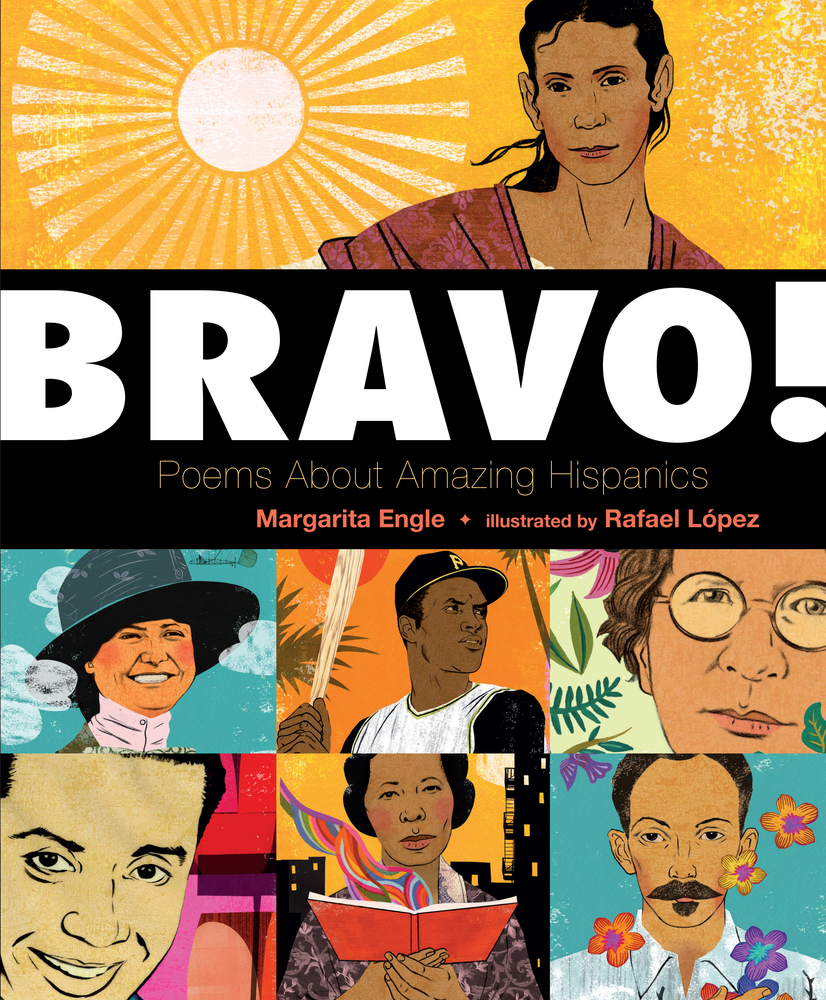
1. Bibliography
Engle, Margarita, and Rafael López (illustrator). 2017. Bravo!: Poems About Amazing Hispanics. New York: Henry Holt and Company. ISBN 9780805098761
2. Plot Summary
Beginning with Juan de Miralles, a Cuban born in 1713, and moving through the 1800s with Mexicans, Cubans, and Puerto Ricans, and into the late 1900s with Mexicans, Puerto Ricans, an El Salvadorian, and a Venezuelan, winner of the Nobel Prize in medicine in 1980, writer Margarita Engle pens short but stunning poetic portraits of both famous Hispanics and Hispanics whose contributions have mostly been hidden from the public eye. From politicians to priests and healers to healthy recipe writers, the cast of characters in Bravo! demonstrates the diversity of the Hispanic community. Illustrator Rafael López has contributed illustrations that use both digital and painterly elements to create eye-catching visuals to match Engle’s powerful text. The front of the book includes a letter to readers from Engle and the end includes notes about the lives of each of the eighteen Hispanics highlighted in the picture book.
3. Critical Analysis
As Margarita Engle explains in her introductory letter to readers, “this is not a book about the most famous Hispanics.” Truly, Engle looks far and wide to create a picture book that shines with the diversity of the movers and shakers that are highlighted in this winning picture book. Readers may be familiar with the names of some Hispanics found in Bravo!—Cuban poet José Martí, for example, or nonviolent protestor César Chávez. But readers probably won’t recognize the names of Hispanics like Aída de Acosta, the world’s first woman pilot, or Ynés Mexía, a botanist that collected an impressive number of new plant species in Mexico and South America. With men and women; rich and poor; Cubans, Puerto Ricans, and Mexicans; and cowboys, librarians, and baseball players, this book truly celebrates the diversity of the Hispanic culture. López’s illustrations also reflect the diversity within the Hispanic world with portraits of heroes and heroines of diverse skin and hair colors, dress, and economic status.
The quality of Engle’s poetry is just as commendable as the diversity of the Hispanics she’s chosen. Although she only has the single page of a picture book spread to explain each amazing Hispanic, Engle finds a way to convey the importance of each life with powerful simplicity. Juana Briones, for example, leaves her cruel husband after he hits her, and—though the 1800s were not kind to single women—survives “as a rancher and healer,” healing others with medicinal plants and “healing [her]self / with independence.” López compliments Engle’s powerful prose with powerful visuals. On the spread dedicated to Juana Briones, he draws a hand with plants blooming within it. While the hand was once the symbol of an abusive spouse—a hand of hurting—Juana decided to turn her own hands into hands of healing. With such a high caliber of poetry and illustrations, Bravo! provides ample fodder for discussion in classrooms, libraries, and homes. This is a must-have for any library dedicated to diversity.
4. Rewards and Review Excerpts
New York Public Library’s 100 Titles for Reading and Sharing List, 2017, Poetry and Song
Tejas Star Reading List, 2018–2019
Américas Award for Children’s and Young Adult Literature, 2018, Commended Title
From Bulletin: “Eighteen Latinos who made their marks in the New World are featured in verses in their own voices attesting to their achievements and their struggles. . . . López’s full page, mixed-media portraiture captures both the nobility and humanity of his subjects. . .”
From CCBC: “Biographical poems introduce 18 Hispanics whose lives, notes author Margarita Engle, range from some who were celebrated in their lifetimes but have been forgotten by history, to others who achieved lasting fame. Even the shortest poems provide a brief but intriguing sense of their subjects lives and accomplishments while nurturing readers desire to learn more. . . Gorgeous full-page portraits of each subject incorporate elements of the work for which they were known, while inspired spot illustrations add to the volume’s beauty.”
5. Connections
Ask children (ages 8 to 12) to read through Bravo! on their own, and then discuss which of the amazing Hispanics stood out to them. Dividing children into groups, asking each group to do a little more research on one of the Hispanics highlighted in the book. Invite children to present their research at an “Amazing Hispanics” night.
Create a display of children’s books written by Margarita Engle, such as the following selections:
- The Surrender Tree: Poems of Cuba’s Struggle for Freedom. ISBN 9780805086744
- Enchanted Air. ISBN 9781481435222
- Mountain Dog. ISBN 9780805095166
- Hurricane Dancers: The First Caribbean Pirate Shipwreck. ISBN 9780805092400
- The Drum Dream Girl. ISBN 9781520018171
- All the Way to Havana. ISBN 9781627796422
*Note—This book review was created as an assignment for a course at Texas Woman’s University.